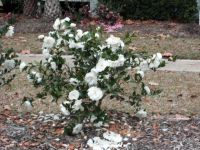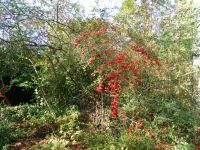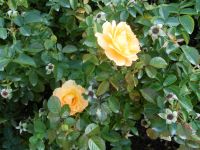
Camellia japonica…
Is a very popular flowering shrub here in the South. Camellia japonica is blooming now and may be planted during this time, Camellias (Camellia japonica) begin to bloom in November and continue through the winter until spring. The Camellia japonica is an evergreen shrub and is a native of China and Japan.
Camellia japonica has leathery, dark & shiny green leaves. Produce large, red, pink, white or variegated flower up to five inches across. The blooms are single, partly or completely double. Camellia japonica has a number of landscape uses as espalier, containers, specimen shrub or old garden shrub. It is long-lived upright plant with a long blooming season. It does best in shaded, understory conditions. Plant in fertile soils, which are porous, well-drained and acidic soil with pH of 5.0 to 6.0. Mulch plants with 2 to 3 inches of material.

Fertilize camellias with an azalea-camellia fertilizer or complete fertilizer such as 2-5-15or similar at one-half pound per well-established plant. Apply fertilizer in late winter just before new growth begins.
Prune after the plant blooms. Camellia japonica may be thinned in the center, for good air circulation. Scale is a serious insect problem and may require annual spraying. Petal blight can also be a problem under wet warm conditions.

Hollies and Other Shrubs for-Winter Fruit
Plants also provide color in fall and fruit in winter. Hollies, with their brilliant red berries, are notable in this regard. Excellent choices for Louisiana include the popular Savannah holly and Foster’s holly (Ilex x attenuata “Savannah’ and ‘Fosteri’), both small trees. Beautiful native hollies include the yaupon holly (Ilex vomitoria), deciduous holly (Ilex decidua) and winterberry (Ilex verticillata). They are excellent wildlife food for birds. Shrubby hollies also produce colorful berries. Varieties include Burford, Dwarf Burford, Nellie R. Stevens, Needlepoint, Dixie Star, Dixie Flame and many others. Other shrubs for wildlife fruit include, Pyracantha (pyracantha coccinea, Rose hips (Rosa), American Beautyberry(Calicarpa Americana) and Nandina (Nandina domestica) to name a few.
Garden Tips
Continue to protect tender perennials from cold with several inches of mulch.
Cut back freeze damaged plants below damaged area after the last frosts of the season.
Protect potted tropical & tender plants from freezes by bringing them indoors. In ground plants can be transplanted to pots or tented by using plastic &wooden steaks. Do not let plastic come into contact with the plant leaves to avoid frost. Return plants outdoors after the threat of frost has past.
Roses can be transplanted through late February.
Also cut back fall-blooming perennials after they have bloomed.

Cool Season Vegetables to Plant in January
Vegetables to plant in January include beets, broccoli, cabbage, carrots, cauliflower, celery, Chinese cabbage, collards, garden peas, kale, kohlrabi, leeks, lettuce, mustard, radishes, rutabaga, snow peas, spinach, Swiss chard, and turnips. Winter is an excellent time to collect soil samples and submit them for analysis before preparing for spring planting. Samples should be a composite of soil taken from about 3 to 4 inches deep at various places around the lawn.
Winter Soils
Now is a good time to have your soil sample tested. Bring about 1 pint of soil to your parish’s LSU AgCenter Extension Service office or a participating garden center. Make sure to specify the type of grass you are growing, type of garden & what you plan to grow on the soil test form. Soil samples submitted to the LSU AgCenter cost about $10, and they provide a wealth of information concerning the overall fertility of your soil.
If results of the soil test indicate the soil pH is too acidic, lime will be prescribed in the soil test recommendations. Winter is the best time to apply lime so it can be fully activated by the following spring. The correct soil pH is extremely important and has everything to do with nutrient availability to your lawn’s roots and to fertilizer performance for your garden.

Preparing Roses for Spring Blooms
Roses should be pruned anytime from late January (south Louisiana) through mid-February (north Louisiana).
This pruning is especially important for hybrid tea and grandiflora roses. Without this annual pruning, these roses generally become leggy, less vigorous and unattractive and do not bloom as well. In general, however, all types of roses usually require some pruning each year to control their shape or size.
Use sharp bypass hand pruners on roses. Should you need to cut canes larger than one-half inch in diameter, you should use bypass loppers. Hybrid tea and grandiflora roses generally are cut back to about 18 to 24 inches from the ground. Other types of roses that are everblooming (such as China, tea, noisette, Bourbon, polyantha, floribunda, landscape and miniature roses) also may be pruned now. In general, roses in these categories have more pleasing shapes without severe pruning. Unless there is a need to control their size, they are only lightly shaped under most circumstances.
First, prune out any dead or diseased canes. To shape the bushes, you can use hand pruners to selectively cut back individual branches. Landscape roses can even be sheared with hedge shears to shape them and encourage full, bushy growth. If some of your bushes are considerably overgrown, they will tolerate severe pruning to get them back into shape. Other than hybrid teas and grandifloras, roses are cut back about one-third to one-half their height, depending on the situation. Long, especially vigorous shoots that have grown well beyond the rest of the bush and make it look out of balance may be cut back further than the rest of the bush. Young bushes planted within the last year or two likely will not need drastic pruning but may be cut back slightly to encourage a full, bushy plant. It is easier and healthier for the rose bush if you prune at least once a year. It is very difficult to properly prune a rose bush that has been allowed to grow for several years without pruning. Don’t forget that we also do a second, but not as severe, pruning on ever blooming roses in late summer through late August.
submitted by Karen Blackburn
